Least Common Multiple
In arithmetic, Least Common Multiple (LCM) of two or more numbers is the least positive number that can be divided by both the numbers, without leaving the remainder. It is also known as Lowest Common Multiple (LCM), Least Common Denominator, and Smallest Common Multiple. It is denoted by LCM (a, b) or lcm (a, b) where a and b are two integers.
It is used when we add, subtract, or compare the fractions. While we perform addition or subtraction of the fractions, we find the LCM of the denominators and then solve the fractions. The LCM of the denominators is known as the Least Common Denominator (LCD).
Properties of LCM
- Associative: LCM (a, b) = LCM (b, a)
- Commutative: LCM (a, b, c) = LCM (LCM (a, b), c) = LCM (a, LCM (b, c))
- Distributive: LCM (ka, kb, kc) = kLCM (a, b, c)
- The LCM is related to GCF:

How to Find LCM
There are three method to find the LCM, are as follows:
- Using Table Method
- Using the Greatest Common Divisor (GCD) Method
- Using Prime Factorization Method
- Using Multiples of Numbers
Using Table Method
It is a simple method and works for any number of numbers. Follow the steps given below to find the LCM.
- List all the given numbers horizontally in the table separated by a comma.
- Start dividing the number(s) by 2 if the numbers(s) are completely divisible. Write 2 at the top of the left column and write the result horizontally. Repeat this process until we do not get the prime number(s) as a result.
- When any number is not divisible by 2, choose the next largest prime number and start dividing the number(s) by that number. Write that number below the 2 and write the result horizontally. Repeat this step until we do not get 1’s in the last row.
- To get the LCM, multiply all the numbers written in the left-most column.
Let’s understand it through examples.
Example 1: Find the LCM of 8 and 10.
Solution:
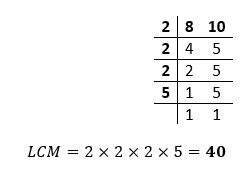
Hence, the LCM of 8 and 10 is 40.
Example 2: Find the LCM of 60 and 282.
Solution:
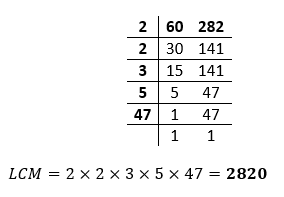
Hence, the LCM of 60 and 282 is 2820.
Example 3: What is the LCM of 20, 28, and 35.
Solution:
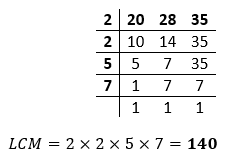
Hence, the LCM of 20, 28, and 35 is 140.
Example 4: Find the LCM of 120, 144, 160, and 180.
Solution:
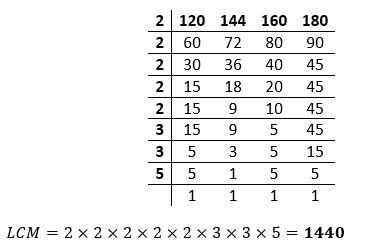
Hence, the LCM of 120, 144, 160, and 180 is 1440.
Example 5: Find the LCM of 64, 72, 96, and 108.
Solution:
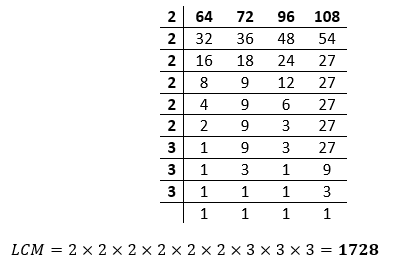
Hence, the LCM of 64, 72, 96, and 108 is 1728.
Using the Greatest Common Divisor (GCD) Method
We can also calculate the LCM by using the GCD. The formula for LCM using the GCD is:

Greatest Common Divisor: It is the highest number that completely divides two or more numbers. It is abbreviated for GCD. It is also known as the Greatest Common Factor (GCF) or the Highest Common Factor (HCF).
How to Find GCD
Follow the steps given below to find the GCD:
- Write all the factors of each number.
- Select the common factors.
- Select the largest number, as GCD.
Let’s understand it through examples.
Example 6: Find the LCM of 8 and 10.
Solution:
According to the formula that we have learned above:
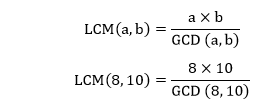
First, we find the GCD of 8 and 10.
Factors of 8: 1, 2, 4, 8
Factors of 10: 1, 2, 5, 10
Common Factors: 1, 2
Greatest Common Divisor: 2
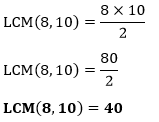
Hence, the LCM of 8 and 10 is 40.
Example 7: Find the LCM of 11 and 42.
Solution:
According to the formula that we have learned above:
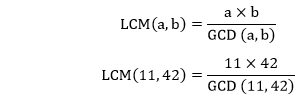
First, we find the GCD of 11 and 42.
Factors of 11: 1, 11
Factors of 42: 1, 2, 3, 6, 7, 14, 21, 42
Common Factors: 1
Greatest Common Divisor: 1
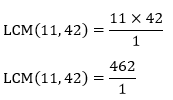
LCM(11,42)=462
Hence, the LCM of 11 and 42 is 462.
Example 8: Find the LCM of 64 and 112.
Solution:
According to the formula that we have learned above:

First, we find the GCD of 64 and 112.
Factors of 64: 1, 2, 4, 8, 16, 32, 64
Factors of 112: 1, 2, 4, 7, 8, 14, 16, 28, 56, 112
Common Factors: 1, 2, 4, 7, 8, 16
Greatest Common Divisor: 16
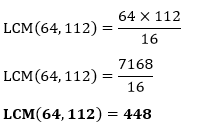
Hence, the LCM of 64 and 112 is 448.
Using Prime Factorization Method
Follow the steps to find the LCM using the prime factorization method.
- Write all the prime factors of the given numbers.
- Select all the prime numbers. As many as they occur most often for anyone given number.
- Multiply all the prime numbers together to get the LCM.
Note: When we write the factors in the form of is called exponential form, and the process is known as factorization using exponents.
Let’s understand through examples.
Example 9: Find the LCM of 17 and 28.
Solution:
Prime factor of 17: 17
Prime factors of 28: 2×2×7
LCM(17,28)=2×2×7×17
LCM (17,28)=476
In exponential form:
Prime factor of 17: 171
Prime factors of 28: 22×71
LCM(17,28)=22×71×171
LCM (17,28)=476
Hence, the LCM of 17 and 28 is 476.
Example 10: What is the LCM of 35 and 78.
Solution:
Prime factor of 35: 5×7
Prime factors of 78: 2×3×13
LCM (35,78)=2×3×5×7×13
LCM (35,78)=2730
In exponential form:
Prime factor of 35: 51×71
Prime factors of 78: 21×31×131
LCM(35,78)=21×31×51×71×131
LCM (35,78)=2730
Hence, the LCM of 35 and 78 is 2730.
Example 11: Find the LCM of 223 and 432.
Solution:
Prime factor of 223: 223
Prime factors of 432: 2 × 2 ×2 × 2 × 3 × 3 × 3
LCM (223,432)=2 × 2 ×2 × 2 × 3 × 3 × 3×223
LCM (223,432)=96336
In exponential form:
Prime factor of 223: 2231
Prime factors of 432: 24×33
LCM (223,432)=24×33×2231
LCM (223,432)=96336
Hence, the LCM of 223 and 432 is 96336.
Example 12: Find the LCM of 12, 23, and 29.
Solution:
Prime factor of 12: 2 × 2 × 3
Prime factors of 23: 23
Prime factors of 29: 29
LCM (12,23,29)=2 × 2 × 3 ×23 × 29
LCM (12,23,29)=8004
In exponential form:
Prime factor of 12: 22×31
Prime factors of 23: 231
Prime factors of 29: 291
LCM (12,23,29)=22×31×231×291
LCM (12,23,29)=8004
Hence, the LCM of 12, 23, and 29 is 8004.
Using Multiples of Numbers
It is a very lengthy method, so it is not usually used. Follow the steps given below to find the LCM using multiples of numbers.
- List all the multiple of each number until the first common multiple is found.
- Pick the smallest multiple that is common in all the given numbers.
Let’s understand it through examples.
Example 13: What is the LCM of 12, 9, and 33.
Solution:
Multiples of 9: 9, 18, 27, 36, 45, 54, 63, 72, 81, 90, 99, 108, 117, 126, 135, 144, 153, 162, 171, 180, 189, 198, 207, 216, 225, 234, 243, 252, 261, 270, 279, 288, 297, 306, 315, 324, 333, 342, 351, 360, 369, 378, 387, 396, 405, 414
Multiples of 12: 12, 24, 36, 48, 60, 72, 84, 96, 108, 120, 132, 144, 156, 168, 180, 192, 204, 216, 228, 240, 252, 264, 276, 288, 300, 312, 324, 336, 348, 360, 372, 384, 396, 408, 420
Multiples of 33: 33, 66, 99, 132, 165, 198, 231, 264, 297, 330, 363, 396, 429, 462
Hence, the LCM of 9, 12, and 33 is 396.
Example 14: What is the LCM of 15 and 16.
Solution:
Multiples of 15: 15, 30, 45, 60, 75, 90, 105, 120, 135, 150, 165, 180, 195, 210, 225, 240, 255, 270
Multiples of 16: 16, 32, 48, 64, 80, 96, 112, 128, 144, 160, 176, 192, 208, 224, 240, 256, 272
LCM (15,16)=240
Hence, the LCM of 15 and 16 is 240.
LCM of Fractions
We can also find the LCM of the fractions by using the following formula:

Example 15: What is the LCM of 

Solution:
LCM of numerators:
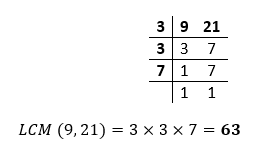
HCF of denominators:
Factors of 2: 1, 2
HCF: 2
Putting the values in the formula, we get:

Hence, the LCM of 


Example 16: What is the LCM of 

Solution:
LCM of numerators:
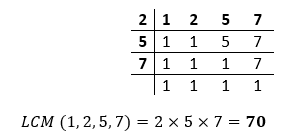
HCF of denominators:
Factors of 2: 1, 2
Factors of 3: 1, 3
Factors of 4: 1, 2, 4
Factors of 5: 1, 5
HCF: 1
Putting the values in the formula, we get:

Hence, the LCM of 

Example 17: What is the LCM of 

Solution:
LCM of numerators:
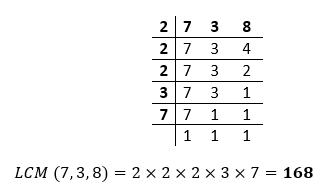
HCF of denominators:
Factors of 9: 1, 3, 9
Factor of 1: 1
Factors of 5: 1, 5
HCF: 1
Putting the values in the formula, we get:

Hence, the LCM of 

